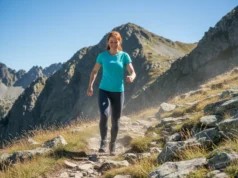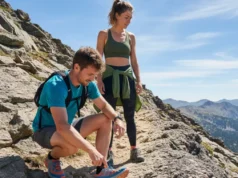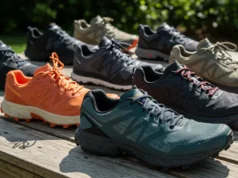In this article
Choosing the right hiking water shoes for canyon hikes presents a unique problem: the terrain is both ruggedly dry and punishingly wet. The most common assumption—that waterproof hiking boots are best—is often the very mistake that can lead to a miserable, blister-filled experience. That high-top, Gore-Tex-lined hiking boot you trust for mountain trails can become your worst enemy when you’re wading chest-deep in the Virgin River.
Let’s dismantle the common myths and arm you with a professional decision framework for your footwear. We’ll move beyond marketing hype to focus on the physics of water, weight, and friction. You will learn the critical, counter-intuitive reason why drainage beats waterproofing in wet canyon environments, the four “jobs” your footwear must perform to keep you safe and comfortable, and see our data-backed top water shoes, matched to specific types of hikers and iconic trails.
What Truly Matters in a Hiking Water Shoe?
Let’s dive into the core principles of water-ready footwear. Understanding them allows you to evaluate any water shoe like an expert and make a choice that truly serves your needs on the trail. It’s not about brand names; it’s about understanding the specific jobs a shoe needs to do when submerged in various waterbodies.
Why is Drainage More Important Than Waterproofing in Canyons?
The logic seems simple: to keep your feet dry, wear waterproof boots. But in environments where water is guaranteed to go over the cuff of your boot, this logic is dangerously flawed. Once water inevitably flows over the top, the very membrane designed to keep water out now traps it in, creating what canyoneers call the “Bucket Effect.” Your boot becomes a heavy, sloshing container of water you have to lift with every single step, especially when wading through puddles or river bottoms.
This trapped water initiates a downward spiral. First, it adds significant weight, leading to premature fatigue. This isn’t just about comfort; according to research on mountain hiking accidents, fatigue and the impaired coordination that comes with it are major factors in fall-related injuries. More critically, the constant soak causes skin maceration, an over-softening of the skin that drastically reduces its resistance to friction. This makes painful, hike-ending blisters from wet socks almost inevitable. The superior approach is a drainage-based system. Non-waterproof hiking and water shoes with mesh uppers and dedicated drainage ports allow water to exit as quickly as it enters. This system, paired with the right wool or neoprene socks, focuses on efficiently managing wetness rather than attempting an impossible prevention, keeping your feet lighter and healthier.
How We Tested and What We Looked For
To build absolute trust, we believe in radical transparency. Our recommendations are the direct result of independent, hands-on testing, free from sponsored placements or brand influence. Our only goal is to help you find the best tool for the job, ensuring your investment enhances your safety and enjoyment on the trail.
Every shoe in this guide was rigorously judged against the four critical performance attributes that define effective water and hiking shoes. We call these the four “jobs”: Wet Traction, Drainage Speed, Protection, and Support. We didn’t just look at marketing claims; we evaluated how well each shoe performed these jobs in the precise environments it was designed for.
Our evaluation process is built on real-world mileage. Each pair of shoes was field-tested by our team for over 60 hours in conditions designed to replicate their target use case. This wasn’t a casual walk. We navigated the slippery, algae-coated rocks of a cold mountain stream and trekked for miles through the fine, abrasive sand of a desert wash to simulate the exact challenges of iconic water-based hiking routes like The Narrows in Zion National Park and Coyote Gulch in the Escalante River drainage.
After synthesizing our extensive field notes and performance data, we translated our findings into the clear, practical recommendations you see below. We’ve tailored our top picks to the distinct needs of different hiker archetypes, ensuring you can match your adventure style to the perfect piece of gear.
The Best Hiking Water Shoes of 2025: Our Top Picks
Here are our top-performing hiking water shoes, categorized not by brand, but by the type of water lover they serve best. We’ve matched each shoe to its ideal use case, from technical canyoneering to all-day trail comfort.
Best for The Narrows & Technical Canyoneering
The Palm Gradient 3.0 is not a casual water shoe; it is a purpose-built water hiking boot engineered for maximum security in the most demanding conditions. It offers unparalleled protection and the most reliable wet-rock traction available, making it the top choice for serious, cold-water canyoneering and navigating slippery rocks. Its performance is rooted in its specialist components, featuring a Vibram Idrogrip outsole—the stickiest rubber compound engineered for grip on wet, slick surfaces. This is paired with a robust, high-top design, a reinforced toe box, and a snug 3mm neoprene cuff that provides immense protection from submerged rocks while sealing out the river grit that plagues lesser aqua shoes for hiking. The trade-off for this bombproof protection is weight and stiffness; this protective shoe is heavy and lacks ground-feel, making it complete overkill for casual hikes.
PROS
- Unmatched wet-rock grip with Vibram Idrogrip
- Superior debris-blocking neoprene cuff
- Bombproof durability and foot protection
- Excellent for cold water and technical use
CONS
- Heavy, stiff, and lacks ground-feel
- Overkill for casual or trail-focused hikes
- More expensive than other options
- Can be difficult to put on initially
The La Sportiva TX Canyon is a masterclass in specialized shoe design, delivering a precise fit and elite grip for the most demanding wet canyons and vertical terrains. Like the Palm boot, its sole utilizes a Vibram IdroGrip compound with a dedicated climbing zone at the toe, ensuring best-in-class friction on technical, wet rock. What sets it apart is its unique drainage and closure system. It features an Ariaprene® upper and an innovative system of medial valve inserts on the arch that exhaust water rapidly while preventing sand from entering—a critical feature for multi-day trips. The Spyral Collar lacing system provides a sealed, sock-like fit around the ankle. This is a highly specialized shoe; its aggressive, stiff construction is built for canyoneering and is not a comfortable water shoe for standard hiking trails.
PROS
- Phenomenal wet grip with a climbing zone
- Excellent at draining water while blocking sand
- Secure, supportive, and protective ankle fit
- Very durable and lightweight for its class
CONS
- Very expensive and highly specialized
- Stiff design is not for general hiking
- Sizing is tricky and requires careful consideration
- Can get hot due to sealed construction
Best for All-Day Comfort on Mixed-Terrain Hikes
The Hoka Hopara 2 is a hybrid sneaker that delivers the brand’s signature maximum cushioning, making it the most comfortable water shoe for long days hiking on trails that mix dry land and water crossings. Its strength lies in its thick EVA midsole, which provides exceptional shock absorption and underfoot comfort, significantly reducing fatigue on rocky, uneven terrain. Unlike open-strap sandals, the Hopara 2 features a fully enclosed design with a 100% recycled knit upper and Cordura® mesh overlays in the toe box. This construction offers excellent toe protection while managing debris far better than traditional sandals. While its sticky rubber outsole provides good traction for most conditions, it’s not on par with approach shoes for canyoneering on extremely slick, algae-covered surfaces. It’s also heavier than other options, and fine silt can sometimes be difficult to flush out without removing the shoe.
PROS
- Maximum cushioning for all-day comfort
- Excellent toe protection in a sandal design
- Versatile for both wet and dry hiking
- Secure fit with adjustable heel strap
CONS
- Heavier than minimalist water shoes
- Fine sand can be hard to flush out
- Traction is good, but not elite on slick rock
- Sole durability can be a concern for some
The KEEN Newport H2 is a consumer favorite and an icon in the world of water-friendly footwear like water hiking sandals. It’s known for its legendary toe bumper, offering a reliable, comfortable, and highly protective option for casual water-friendly hikes and activities like kayaking and rafting. The patented rubber toe bumper is its standout feature, providing robust protection against stubbing the toe on unseen rocks, a common hazard in aquatic environments. The open-strapping system, made of washable polyester webbing, provides maximum drainage and ventilation. However, this open design is also its primary weakness; sand and pebbles can enter easily, which can become a major irritant on tough river hikes like The Narrows. Its traction and support are sufficient for moderate trails but not for a full canyoneering adventure.
PROS
- Legendary toe bumper offers superb protection
- Excellent drainage and ventilation
- Very comfortable with good arch support
- Highly versatile for casual wear and water sports
CONS
- Open design lets in sand and small rocks
- Heavier and bulkier than other sandals
- Not enough support for technical terrain
- Can take longer to dry completely
Best for Agility, Grip, and Versatility
The Astral Brewer 2.0 is an exceptionally lightweight and flexible shoe that provides supreme grip and a barefoot-like feel underfoot, making it perfect for the agile hiker, paddlers on their favorite watercraft, and scramblers who value connection with the terrain. Its performance is anchored by Astral’s G.15™ sticky rubber outsole, a non-marking compound that excels at gripping slick, wet surfaces with confidence. The design is minimalist, with a Balanced Geometry™ midsole that has zero-drop from heel to toe, promoting natural balance. This minimalist construction, roomy toe box, and a clever collapsible heel—which allows it to be worn as a slip-on design camp shoe—make it incredibly comfortable and versatile. The primary trade-off is protection. The minimalist design offers less underfoot cushioning and protection from sharp rocks/reefs.
PROS
- Superlative grip on wet, slick surfaces
- Lightweight, flexible, and excellent ground-feel
- Drains and dries very quickly
- Versatile as a sneaker, water shoe, and camp shoe
CONS
- Minimalist cushioning can fatigue feet
- Less underfoot and side-foot protection
- Some users report durability issues over time
- Interior stitching can cause rubbing for some
Final Considerations & Common Mistakes to Avoid
Before you click “buy,” review these final points to ensure you get the most out of your investment and avoid common pitfalls that can derail an otherwise perfect adventure.
Don’t Forget the Sock System: The shoe is only half the system. For heavy hiking in cold water, such as a top-down trip through The Narrows, warm neoprene sock options are non-negotiable for warmth, comfort, and safety. They insulate even when wet. For all other wet hiking in warmer conditions, choose thin merino wool socks. They manage moisture, regulate temperature, and, most importantly, retain their structure when wet to help prevent blisters. Avoid cotton at all costs.
Prioritize Fit Over Features: Even the most technologically advanced shoe will fail you if it doesn’t fit correctly. A sloppy fit is a direct path to blisters and instability. Always try on footwear at the end of the day when your feet are slightly swollen, and be sure to wear the exact type of socks you plan to hike in. You should have a locked-in heel with no lift or slip, while also having adequate room for your toes to splay within the toe box.
Acknowledge the Rental Option: For a one-time, highly specialized hike like The Narrows in Zion, renting the proper camping gear is often the smartest choice. Local outfitters provide a full package including purpose-built water hiking boots, neoprene socks, and a sturdy walking staff. This is often the safest, most practical, and most cost-effective solution for a single trip, allowing you to use professional-grade equipment without the long-term investment.
Frequently Asked Questions about Hiking Water Shoes
Can I just use my regular hiking sandals like Tevas or Chacos in a canyon?
For casual stream crossings, they can work, but for serious water hikes, this is generally not recommended. Their open-toed design offers zero protection from submerged rocks, a significant safety risk. Furthermore, their strapping systems can struggle to prevent your foot from sliding on the footbed when wet. For technical hikes like The Narrows, a closed-toe shoe model like the KEEN shoe is a much safer option that also does a better job managing debris.
What is the most important feature to look for in a hiking water shoe?
While all features matter, for wet, rocky environments like canyons and riverbeds, superior wet traction on slippery rocks is the single most important safety feature. A slip can easily lead to a serious injury. Look for water shoes for hiking with specialist sticky rubber soles designed specifically for these conditions, such as the Vibram Idrogrip found on the Palm Gradient 3.0 and La Sportiva TX Canyon, or the G.15 rubber used on the Astral Brewer 2.0.
Do I really need to buy expensive canyoneering shoes for one trip?
Absolutely not. For a single trip to a world-class destination like The Narrows, renting a full pack (boots, neoprene socks, walking staff) from a Zion outfitter is the most recommended approach for most people. It’s cost-effective and ensures you have the right tool for the job. However, if you plan to do frequent canyon or river hikes, investing in a durable water shoe like the La Sportiva TX Canyon can be a worthwhile long-term safety investment.
Should I choose a quick-drying trail runner or a dedicated water shoe?
This depends entirely on the ratio of land to water on your hike. If your route is 90% dry trail with a few stream crossings, a trail running shoe with good drainage is an excellent choice. But if your hike involves prolonged wading, constant submersion, and moving through strong currents, a dedicated water shoe is better as it prevents soggy shoes. It will drain faster, have a stickier outsole, and be built with materials that won’t break down from constant saturation. A hybrid model like the Hoka Hopara 2 effectively bridges this gap, offering the support of a trail shoe with the drainage and materials of a water shoe.
Risk Disclaimer: Hiking, trekking, backpacking, and all related outdoor activities involve inherent risks which may result in serious injury, illness, or death. The information provided on The Hiking Tribe is for educational and informational purposes only. While we strive for accuracy, information on trails, gear, techniques, and safety is not a substitute for your own best judgment and thorough preparation. Trail conditions, weather, and other environmental factors change rapidly and may differ from what is described on this site. Always check with official sources like park services for the most current alerts and conditions. Never undertake a hike beyond your abilities and always be prepared for the unexpected. By using this website, you agree that you are solely responsible for your own safety. Any reliance you place on our content is strictly at your own risk, and you assume all liability for your actions and decisions in the outdoors. The Hiking Tribe and its authors will not be held liable for any injury, damage, or loss sustained in connection with the use of the information herein.
Affiliate Disclosure: We are a participant in the Amazon Services LLC Associates Program, an affiliate advertising program designed to provide a means for us to earn advertising fees by advertising and linking to Amazon.com. As an Amazon Associate, we earn from qualifying purchases. We also participate in other affiliate programs and may receive a commission on products purchased through our links, at no extra cost to you. Additional terms are found in the terms of service.





